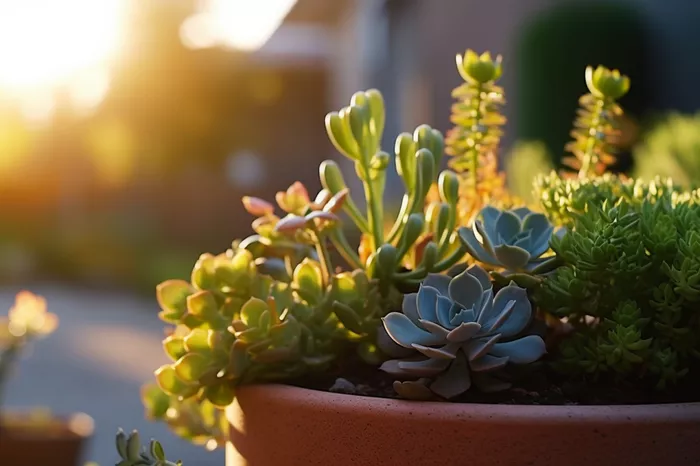The zebra succulent also known as Haworthia fasciata, is a charming and unique plant that can add a touch of elegance to any indoor or outdoor space. With its distinctive striped leaves, it is a favorite among succulent enthusiasts. Here are some tips on how to care for a zebra succulent.
Understanding the Zebra Succulent
The zebra succulent is a small, slow-growing plant that is native to South Africa. It has thick, fleshy leaves that are arranged in a rosette pattern. The leaves are usually green with white stripes, giving it a zebra-like appearance. This succulent is relatively easy to care for and can tolerate a wide range of growing conditions.
Choosing the Right Pot and Soil
Pot Selection
When choosing a pot for your zebra succulent, select one that has drainage holes. Succulents do not like to sit in water, so good drainage is essential. A terra cotta pot is a good choice as it is porous and allows excess moisture to evaporate.
Soil Requirements
Zebra succulents require well-draining soil. A good succulent soil mix typically contains a combination of potting soil, perlite, and sand. This combination provides good drainage while also retaining some moisture. Avoid using heavy soils such as garden soil or topsoil, as these can hold too much moisture and cause the roots of the plant to rot.
Watering
Frequency
Zebra succulents are drought-tolerant plants and do not need to be watered frequently. Water your zebra succulent only when the soil is completely dry. This can vary depending on the climate and humidity, but as a general rule, you can water your plant once every two to three weeks.
Watering Method
When watering your zebra succulent, be sure to water thoroughly. Pour water onto the soil until it runs out of the drainage holes. Avoid getting water on the leaves of the plant, as this can cause them to rot. After watering, allow the soil to dry completely before watering again.
Lighting
Sunlight Needs
Zebra succulents require bright, indirect sunlight. They can tolerate some direct sunlight, but too much can cause the leaves to burn. Place your zebra succulent near a window that receives bright, indirect light for most of the day. If you are growing your plant outdoors, provide some shade during the hottest part of the day.
Avoiding Extreme Light Conditions
Avoid placing your zebra succulent in a location that is too dark or too bright. Insufficient light can cause the plant to become leggy and weak, while too much light can damage the leaves. If you notice that your plant is not thriving, try moving it to a different location with more or less light.
Temperature and Humidity
Temperature Range
Zebra succulents prefer temperatures between 60°F and 80°F. They can tolerate some fluctuations in temperature, but extreme heat or cold can damage the plant. Avoid placing your zebra succulent near drafts or heat sources such as radiators or air conditioners.
Humidity Levels
Zebra succulents are adapted to arid conditions and do not require high humidity. In fact, high humidity can cause the leaves to rot. Keep your plant in a dry environment with low humidity.
Fertilizing
Fertilizer Needs
Zebra succulents do not require a lot of fertilizer. You can fertilize your plant once or twice a year with a balanced, water-soluble fertilizer. Dilute the fertilizer to half strength and apply it to the soil around the base of the plant.
Avoiding Overfertilization
Be careful not to overfertilize your zebra succulent, as this can cause the leaves to become soft and mushy. Follow the instructions on the fertilizer package carefully and do not apply more than recommended.
Pruning and Propagation
Pruning
Zebra succulents do not require much pruning, but you can remove any dead or damaged leaves to keep the plant looking neat and healthy. Use clean, sharp scissors or pruning shears to make clean cuts.
Propagation
Zebra succulents can be propagated by offsets or leaf cuttings. Offsets are small plants that grow at the base of the parent plant. You can carefully remove these offsets and plant them in their own pots. Leaf cuttings can also be used to propagate the plant. Cut a healthy leaf from the parent plant and allow it to dry for a few days. Then, place the leaf on top of well-draining soil and mist it regularly. After a few weeks, roots will begin to grow, and a new plant will form.
Pest and Disease Control
Common Pests
Zebra succulents are relatively resistant to pests, but they can still be affected by mealybugs, aphids, and scale insects. Inspect your plant regularly for signs of pests, such as white cottony masses, sticky residue, or distorted leaves.
Pest Control Methods
If you notice pests on your zebra succulent, you can try removing them by hand or using a cotton swab dipped in rubbing alcohol. You can also use an insecticidal soap or neem oil spray to control pests. Be sure to follow the instructions on the product label carefully.
Diseases
Zebra succulents can be affected by diseases such as root rot and fungal infections. To prevent diseases, make sure your plant is planted in well-draining soil and avoid overwatering. If you suspect your plant has a disease, remove the affected parts and treat it with a fungicide.
Conclusion
caring for a zebra succulent is relatively easy as long as you provide it with the right growing conditions. Choose the right pot and soil, water sparingly, provide bright, indirect sunlight, and keep the temperature and humidity within the appropriate range. With proper care, your zebra succulent will thrive and bring beauty to your home or garden for years to come.
Releated topic:


